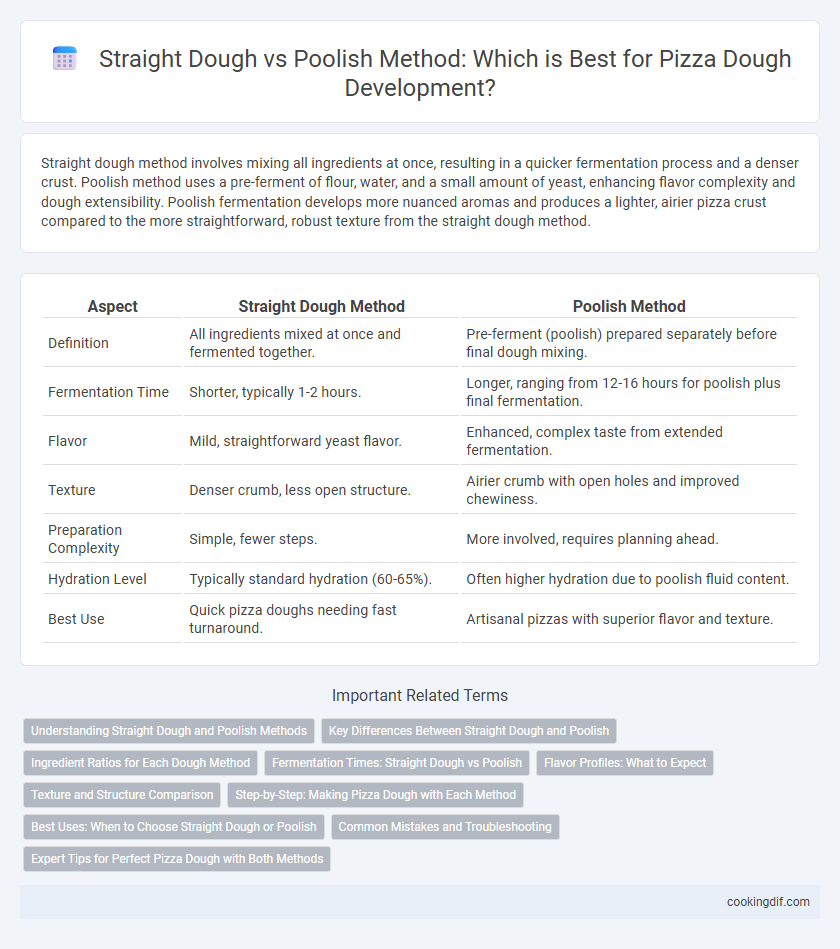Straight dough method involves mixing all ingredients at once, resulting in a quicker fermentation process and a denser crust. Poolish method uses a pre-ferment of flour, water, and a small amount of yeast, enhancing flavor complexity and dough extensibility. Poolish fermentation develops more nuanced aromas and produces a lighter, airier pizza crust compared to the more straightforward, robust texture from the straight dough method.
Table of Comparison
| Aspect | Straight Dough Method | Poolish Method |
|---|---|---|
| Definition | All ingredients mixed at once and fermented together. | Pre-ferment (poolish) prepared separately before final dough mixing. |
| Fermentation Time | Shorter, typically 1-2 hours. | Longer, ranging from 12-16 hours for poolish plus final fermentation. |
| Flavor | Mild, straightforward yeast flavor. | Enhanced, complex taste from extended fermentation. |
| Texture | Denser crumb, less open structure. | Airier crumb with open holes and improved chewiness. |
| Preparation Complexity | Simple, fewer steps. | More involved, requires planning ahead. |
| Hydration Level | Typically standard hydration (60-65%). | Often higher hydration due to poolish fluid content. |
| Best Use | Quick pizza doughs needing fast turnaround. | Artisanal pizzas with superior flavor and texture. |
Understanding Straight Dough and Poolish Methods
Straight dough method involves mixing all ingredients simultaneously, leading to a straightforward and consistent dough with a shorter fermentation time ideal for quick pizza production. Poolish method uses a pre-ferment made by combining flour, water, and a small amount of yeast, enhancing dough flavor and texture through extended fermentation. This technique improves gluten development and crumb structure, resulting in a more aromatic and airy pizza crust.
Key Differences Between Straight Dough and Poolish
Straight dough method uses all ingredients mixed at once, resulting in a quicker fermentation and a denser texture. Poolish method incorporates a pre-ferment of equal parts flour and water with a small amount of yeast, leading to enhanced flavor complexity and a lighter, airier crust. Key differences include fermentation time, dough hydration, and resultant taste profile, with poolish typically requiring longer fermentation for optimal dough development.
Ingredient Ratios for Each Dough Method
Straight dough method typically uses a simpler ratio of flour to water, often around 60% hydration, with yeast and salt mixed directly into the flour. Poolish method requires equal parts flour and water by weight to create a sponge with about 100% hydration, along with a small amount of yeast for fermentation. This pre-ferment stage in poolish enhances gluten development and flavor through longer fermentation compared to the straightforward ingredient blend of the straight dough method.
Fermentation Times: Straight Dough vs Poolish
Fermentation times differ significantly between the straight dough and poolish methods, impacting dough flavor and texture development. The straight dough method involves a single fermentation phase lasting 1 to 2 hours, resulting in a faster but less complex flavor profile. The poolish method employs a longer pre-fermentation phase of 12 to 16 hours, enhancing dough extensibility and imparting deeper flavor due to the extended enzymatic activity and yeast fermentation.
Flavor Profiles: What to Expect
Straight dough method develops a straightforward and slightly yeasty flavor, with a denser crumb and quicker fermentation process. Poolish method enhances complexity by producing a tangy, mildly sour taste and a lighter, airier crumb due to its extended fermentation and use of a pre-ferment. The poolish technique often results in more nuanced, layered flavors ideal for artisan-style pizzas.
Texture and Structure Comparison
Straight dough method produces a denser, chewier pizza crust due to its direct mixing and shorter fermentation time, resulting in a tight crumb structure. Poolish method enhances gluten development and fermentation, yielding a lighter, airier crust with more open holes and a tender bite. The poolish technique improves dough extensibility and flavor complexity, contributing to a superior texture and crumb uniformity in the finished pizza.
Step-by-Step: Making Pizza Dough with Each Method
Straight dough method involves mixing all ingredients simultaneously, kneading until a smooth elasticity forms, followed by a bulk fermentation of 1 to 2 hours at room temperature. Poolish method requires preparing a preferment by combining equal parts flour and water with a small amount of yeast, fermenting it for 12 to 16 hours, then mixing it with the remaining ingredients and kneading until smooth. Both techniques demand a final proofing stage of about 1 hour to develop gluten structure and enhance dough flavor before shaping and baking.
Best Uses: When to Choose Straight Dough or Poolish
Straight dough method is best suited for quick pizza preparations requiring a straightforward, efficient process with consistent results, ideal for everyday pizza making in busy pizzerias. Poolish method excels in artisanal pizzas, enhancing flavor complexity and crust texture through extended fermentation, making it perfect for gourmet or Neapolitan-style pizzas where a deeper taste and airy crumb are desired. Choosing between them depends on the desired dough characteristics and production time, with poolish offering superior flavor and straight dough providing speed.
Common Mistakes and Troubleshooting
Straight dough method often causes dense, less flavorful crusts due to insufficient fermentation time or improper yeast quantities. Poolish method mistakes include over-fermentation leading to overly sour dough or under-fermentation causing poor dough extensibility and weak gluten structure. Troubleshooting requires precise timing, consistent temperature control, and accurate hydration levels to optimize dough elasticity and flavorful development.
Expert Tips for Perfect Pizza Dough with Both Methods
Expert tips for perfect pizza dough start with understanding that the straight dough method requires precise ingredient measurement and thorough kneading to develop gluten quickly for optimal texture. The poolish method involves fermenting a pre-ferment mixture of flour, water, and yeast, enhancing flavor complexity and dough extensibility through longer fermentation. Temperature control and fermentation time are critical in both methods to achieve a balanced crust with ideal chewiness and aeration.
Straight dough vs poolish method for dough development Infographic

 cookingdif.com
cookingdif.com